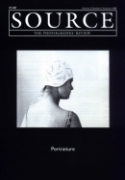Sex Shops
'Sex Shop' by Paul Seawright was on show in the Galerie du Jour, Paris, November 1996
Review by Paul McNally
Issue 9 Autumn 1996
View Contents ▸
Paul Seawright's present work is shown as part of an untitled group exhibition at the Kerlin Gallery, Dublin. He is the only artist represented working with photography as a medium for the exploration of environments and the politics of inhabiting them. This is what Paul Seawright does, his fascination is the human space and the history of people who have occupied it. An especial fascination are those involved in areas or actions of society that will divide and partition people (the viewer?) by the nature of their own morality.
Through this set of photographs we experience emptied spaces devoid of inhabitants in an area that appears both public (utilitarian) yet intimate (decorative). The nature of the show means we are unable to deal with a set of photographs as an neutral representation of a space. They could appear in a colour supplement to many British newspapers but they have size (around a metre square) which is almost life scale and there are 5 placed in a horizontal. You must treat them installationally and physically or risk not dealing with them properly. They are the first works you see as you enter the show and you position yourself physically at (if not in) the environments. The other artists exhibiting use the spaces installationally rather than in a pictorial style. Ronan McCrea's bus shelter like structure of wood in the corner of the gallery which defeats the spectators attempts to view the source of red light which illuminates the wall behind. Daphne Wright's forest of false trees 'Lots of wives II' fills a width and depth of the gallery which prevents free movement through the whole space and Phelan/McLoughlin's sound and text (Morse code) installation physically takes over the gallery with it's soundspace.
These colour photographs have an aesthetic blandness, they ostensibly show curtains in a dark harshly illuminated environment (possibly due to the use of flash) whilst there is still the impression of a 40 watt bulb illuminating a much too large space. This has associations with environments like football stadiums, working men's clubs, prisons and other institutions that have strong histories of male involvement or dominance. The spaces are uncomfortable, harsh and in some way unclean, if not actually dirty, they convey an attitude of filth, and a constant and unrelenting moralism that is impossible to escape.
The hint of human existence is a constant allusion. The shabbiness of the curtains is emphasised by their once decorative nature. Some appear to have had a domestic past life they are palm tree prints or red velvet others look as if they were once a heavy duty PVC carpet. The quality of the interiors will be familiar to anyone who has seen 'Inside Information', the haunting claustrophobia of a taboo environment, the sense of things being 'vaguely familiar'. The knowledge that all is not well starts to take hold.
Depending on which side you start from you get to the porn-video cases sooner or later. They say 'gang-bang', they show a tiny picture on the side depicting some unclothed figures. I came to this part of the work after most of the other pieces and it's the only definite 'proof' we have for all those suspicions raised but not articulated fully. The man's shoe showing from beneath the curtain, the squalor, that suspicion of the environment- we can't even trust a representation of the place, never mind actually visiting it.
We see Paul Seawright's continuing exploration of male institutions and environments. He has a theme running through his work: our attention to peripheral detail is precisely what informs us of our environment, to it's physicalities and it's culture; observing the minutiae of our exterior world will inform our interior selves. However the sense of humanity present in 'Sectarian Murder' is perhaps lacking in this work, and the neutrality of the photographer that worked for 'Inside Information' appears as indecision. All the elements are present for a good work, and the installation is interesting and bold, but it fails to spark the contentiousness possible for such a highly charged subject.
Other articles by Paul McNally:
Other articles mentioning Paul Seawright:
Other articles on photography from the 'Institutional' category ▸






